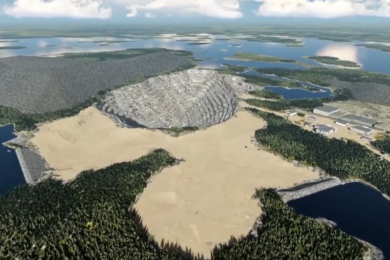First Mining Gold looking to advanced flotation tech & trolley assist truck haulage in Springpole project feasibility study

First Mining Gold Corp has provided an update on the ongoing technical work at its Springpole Gold Project located in northwestern Ontario which is one of the largest, undeveloped, open-pit gold deposits in Canada with reserves of 3.8 Moz of gold at 0.97 g/t, plus 20.5 Moz of silver at 5.2 g/t. The project is expected to see average annual gold production of 335,000 oz in years 1 through 9. The PFS contemplates an open pit mine and milling operation, evaluating recovery of gold and silver from a 30,000 t per day operation, with a process plant that includes crushing, grinding and flotation, with fine grinding of the flotation concentrate and agitated leaching of both the flotation concentrate and the flotation tails followed by a carbon-in-pulp recovery process to produce doré bars.
Since completing the pre-feasibility study for Springpole in January 2021, First Mining has been engaged in a number of significant technical programs to further optimise the development plan for Springpole and to further define the project scope for the Environmental Assessment (EA) process and into the Feasibility Study (FS) process. These programs are ongoing and include feasibility-level metallurgical test work, reviewing opportunities to reduce the project’s greenhouse gas footprint (GHG), exploring renewable power generation opportunities, environmental data collection, and EA document preparation.
The focus of the feasibility-level metallurgical program is to confirm metallurgical information and the process design of the Springpole PFS and explore opportunities to enhance metal recoveries and reduce operating and capital costs for Springpole by testing advanced flotation technologies, including Woodgrove’s Direct Flotation Reactor. The metallurgical testing in 2021 took 2.4 t of metallurgical samples collected from 10 drill holes to form three production composites that underwent advanced metallurgical testing, as well as 10 variability composites. The initial results support the test work and assumptions that were used in the Springpole PFS and warrant a more detailed analysis of simplifying the flotation flow sheet, compared to the Springpole PFS.
Filtration test work is also underway to optimise the size of the filter plant that will feed a dry-stack tailings facility. There is a potential opportunity to reduce the size of the filter plant which may represent a potential decrease to the initial process plant capital cost, when compared to the Springpole PFS. More detailed analysis will be completed during the FS. First Mining will release results from the metallurgical program when it is completed, which is expected to be in Q2 2022.
Following the completion of the Springpole PFS, First Mining completed an analysis of potential GHG emissions from the project and determined that opportunities exist to reduce GHG emissions by reducing diesel consumption associated with the haul trucks with the addition of trolley assist in various areas of the mine. Given that the Project is scoped to be tied to the power grid, First Mining commissioned AGP Consulting to study the impact and benefit of a number of electric haul assist technologies. More detailed analysis is warranted and will be carried out during the FS.
First Mining also commissioned SLR Consulting to complete an initial scoping study of the opportunities to incorporate renewable power generation into the project development plan at Springpole. The Springpole area is endowed with potentially economic wind and solar resources, as well as a significant biomass opportunity which has been previously studied for the region. The SLR study concluded that wind and solar were both viable potential supplemental power sources for the Project that warrant further study. In furtherance of this, First Mining has commenced site-specific, investment grade data collection for wind resources and will explore opportunities with the local communities to better understand avenues for partnership in a potential renewable power development.
This article was originally published on the International mining website.